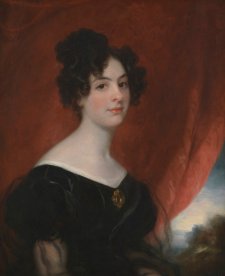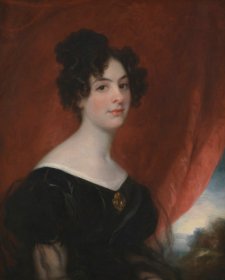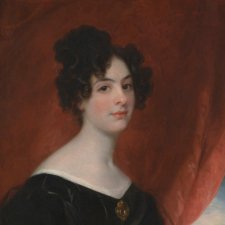- About us
- Support the Gallery
- Venue hire
- Publications
- Research library
- Organisation chart
- Employment
- Contact us
- Make a booking
- Onsite programs
- Online programs
- School visit information
- Learning resources
- Little Darlings
- Professional learning
Ellen Stirling (née Mangles, 1807–1874) was known in her lifetime as the ‘mother of Western Australia’. The daughter of James Mangles – an East India Company director and Member of Parliament – Ellen was thirteen when she snared the attention of naval officer James Stirling (1791–1865), a family acquaintance. Described as ‘adventurous, not yet introduced to the simpering ways of high society, well–educated, amusing and attractive’, Ellen is held by family lore to have been appealing to Stirling for her energy and lack of affectation. They were married on her sixteenth birthday in September 1823 and their first child was born the following year. In 1827, Stirling was given command of a voyage commissioned with identifying a new site for a British garrison on the west Australian coast. On his return to London, he presented the Colonial Office with a case for the establishment of a settlement on the Swan River. He was appointed lieutenant-governor of the new colony and in early 1829 Ellen sailed with him to the place that became Perth. Ellen’s unpretentious manner served her well in a colony that, for the early part of Stirling’s tenure, was a dishevelled assortment of tents and timber houses. Stirling’s surveyor-general, John Septimus Roe, considered her ‘affable and unaffected’ and her friend Georgiana Molloy wrote of Ellen as ‘exceedingly amiable and pleasingly natural’.
Ellen maintained a gentrified style of living and as the colony’s pre-eminent lady presided at race meetings, hunts and other ‘entertainments’. Her charm and youth are said to have reflected well on her husband, softening some of the criticism of his governorship. Ellen had seven children during her ten years in Western Australia and another three following her return to Britain. Sir Thomas Phillips (1770–1845) was one of Regency London’s most prolific and fashionable portraitists. He first exhibited at the Royal Academy in 1792 and by 1796 was primarily occupied with portraiture. Among his subjects were botanist Sir Joseph Banks; explorer Sir John Franklin; poets William Blake and Lord Byron; and scientist Michael Faraday. Records held by the National Portrait Gallery in London show that Ellen Stirling sat for Phillips just before she left for Australia, at which time she was several months pregnant with her second child. Her portrait was displayed in the Mangles family home in Surrey and remained in the possession of Ellen’s descendants until acquired by the National Portrait Gallery in 2008.
Purchased with funds provided by the Ian Potter Foundation 2008
The Ian Potter Foundation (9 portraits supported)



On one level The Companion talks about the most famous and frontline Australians, but on another it tells us about ourselves.



1 May 2016
When did notions of very fine and very like become separate qualities of a portrait? And what happens to 'very like' in the age of photographic portraiture?



Joanna Gilmour explores the life of colonial women Lady Ellen Stirling, Eliza Darling, Lady Eliza Arthur, Elizabeth Macquarie and Lady Jane Franklin.